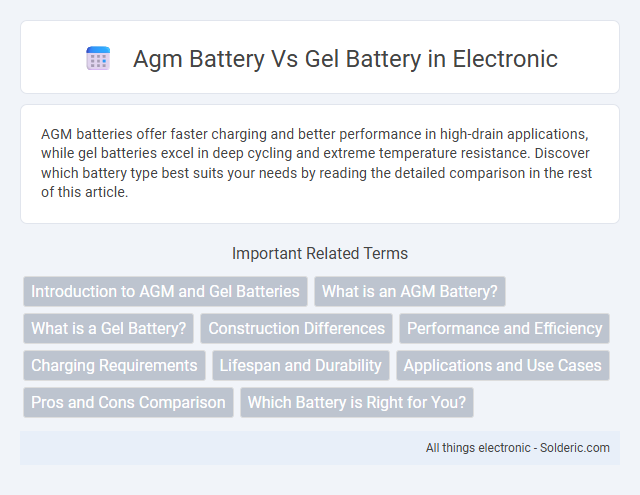AGM batteries offer faster charging and better performance in high-drain applications, while gel batteries excel in deep cycling and extreme temperature resistance. Discover which battery type best suits your needs by reading the detailed comparison in the rest of this article.
Comparison Table
| Feature | AGM Battery | Gel Battery |
|---|---|---|
| Electrolyte Type | Absorbed Glass Mat (AGM) | Gelled Electrolyte |
| Maintenance | Maintenance-free | Maintenance-free |
| Charge Efficiency | High charge acceptance | Lower charge efficiency than AGM |
| Discharge Rate | Good high discharge rates | Better for deep discharge cycles |
| Temperature Tolerance | Works well in cold conditions | Performs better in high temperatures |
| Lifespan | 3-5 years | 4-7 years |
| Cost | Moderate | Higher initial cost |
| Best Use | Start-stop engines, power sports | Deep cycle applications, solar power |
Introduction to AGM and Gel Batteries
AGM (Absorbent Glass Mat) batteries feature a highly porous fiberglass mat separator that absorbs electrolyte, providing spill-proof and vibration-resistant performance ideal for automotive and marine applications. Gel batteries use a silica-based gel to immobilize the electrolyte, offering superior deep-cycle performance and excellent resistance to temperature extremes. Your choice hinges on specific needs like high current delivery or deep discharge capacity in varying environmental conditions.
What is an AGM Battery?
An AGM (Absorbent Glass Mat) battery uses a fiberglass mat to absorb and contain the electrolyte, providing enhanced spill resistance and improved vibration tolerance compared to traditional flooded batteries. These batteries deliver higher power output and faster recharge times, making them ideal for applications requiring reliable starting power and deep cycling capabilities. AGM technology also features lower self-discharge rates and maintenance-free operation, optimizing performance in automotive, marine, and renewable energy systems.
What is a Gel Battery?
A gel battery is a type of sealed lead-acid battery that uses a silica-based gel electrolyte, which provides enhanced resistance to vibration and leakage compared to traditional flooded batteries. This gel electrolyte allows for deeper discharge cycles and improved performance in extreme temperatures, making gel batteries ideal for off-grid solar systems, marine applications, and backup power. Their maintenance-free design and superior durability increase the lifespan and safety of energy storage solutions.
Construction Differences
AGM batteries use a fiberglass mat to absorb electrolyte, creating a sealed and spill-proof design, while gel batteries contain silica to thicken the electrolyte into a gel form, preventing leakage and improving shock resistance. The construction of AGM batteries allows for higher power output and faster charging, whereas gel batteries are designed for deep cycling and longer lifespan in harsh environments. Understanding these construction differences can help you choose the most suitable battery for your specific application and performance needs.
Performance and Efficiency
AGM batteries offer higher efficiency in high-drain applications due to faster charging and lower internal resistance, making them ideal for vehicles and renewable energy systems. Gel batteries provide superior performance in deep-cycle use, with enhanced resistance to vibration and temperature extremes, ensuring longer lifespan in off-grid and marine environments. Both battery types employ sealed lead-acid technology but differ in electrolyte composition, influencing their charge acceptance and discharge characteristics.
Charging Requirements
AGM batteries require a charging voltage typically between 14.4 to 14.7 volts and benefit from a controlled charging profile to prevent overcharging and extend lifespan. Gel batteries need a lower charging voltage, generally around 13.8 to 14.1 volts, with a slow and steady current to avoid gas buildup and potential damage. Properly matching the charger settings to each battery type is essential to maintain optimal performance and longevity.
Lifespan and Durability
AGM batteries typically offer a lifespan of 3 to 5 years and excel in durability with their sealed, vibration-resistant design, making them ideal for high-drain applications. Gel batteries last longer, often reaching 5 to 7 years, due to their gel electrolyte that prevents acid stratification and reduces maintenance needs. Both battery types provide robust performance, but gel batteries are superior in deep-cycle longevity and withstanding extreme environmental conditions.
Applications and Use Cases
AGM batteries excel in automotive starting applications, backup power systems, and marine environments due to their spill-proof design and ability to deliver high burst currents. Gel batteries are ideal for deep-cycle applications such as solar energy storage, electric wheelchairs, and remote telecommunications, where consistent, long-lasting power and resistance to vibration are critical. Your choice depends on whether you need rapid power delivery or sustained energy output in challenging conditions.
Pros and Cons Comparison
AGM batteries offer rapid charging and superior cold-weather performance with a low self-discharge rate, but their lifespan can be shorter under deep discharge cycles. Gel batteries excel in deep cycling, provide excellent resistance to vibration, and have a longer service life, while their slower charge acceptance and higher upfront cost can be limiting factors. Both battery types are maintenance-free and sealed, making them leak-proof and suitable for various applications, but selection depends on specific usage demands like cycle depth, charging speed, and budget constraints.
Which Battery is Right for You?
AGM batteries offer high power output and fast recharging, making them ideal for applications requiring quick bursts of energy, such as automotive starters and power sports. Gel batteries provide superior deep-cycle capabilities and longer lifespan in harsh conditions, suited for solar energy storage, marine use, and off-grid systems. Choosing the right battery depends on your specific power demands, environmental conditions, and maintenance preferences.
Agm battery vs gel battery Infographic

 solderic.com
solderic.com